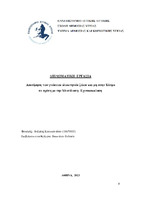Αποτίμηση των γνώσεων ιδιοκτητών ζώων και μη στην Κύπρο σε σχέση με την Υδατίδωση- Εχινοκοκκίαση
Animal and no animal owners' knowledge and perceptions in Cyprus concerning echinococcosis

Keywords
Εχινοκοκκίαση ; Υδατίδωση ; Εκστρατεία ενημέρωσης ; Ιδιοκτήτες ζώων ; Εchinococcosis ; hydatidosis ; Κnowledge ; Pet owners ; Public health ; Awareness campaignAbstract
Η υδατίδωση/εχινοκοκκίαση είναι ένα παρασιτικό νόσημα που οφείλεται στον Echinococcus granulosus. Ο σκύλος διασπείρει στο περιβάλλον με αυγά από τα κόπρανα του και από εκεί μολύνονται φυτοφάγα ζώα και ο άνθρωπος. Στην Κύπρο η ζωονόσος ήταν πολύ διαδεδομένη στο παρελθόν με πολλά κρούσματα στον άνθρωπο. Γι΄ αυτόν το λόγο, από το 1971 ξεκίνησε ένα πρόγραμμα καταπολέμησης της νόσου που χρειάστηκε να επικαιροποιηθεί το 1994 ώστε τελικά το 1998 να ολοκληρωθεί με επιτυχία.
Σκοπός της παρούσας μελέτης, είναι να ερευνήσει τις γνώσεις του γενικού πληθυσμού στη περιοχή Μονής Λεμεσού, είτε έχουν σκύλο είτε όχι, σχετικά με την υδατίδωση/εχινοκοκκίαση. Για το λόγο αυτό διανεμήθηκαν 400 ερωτηματολόγια στη διάρκεια των εκδηλώσεων του Δήμου το καλοκαίρι του 2022.
Από τα ευρήματα της μελέτης προκύπτει ότι πολλοί ερωτηθέντες δεν ήξεραν καν τον εχινόκοκκο, και το μεγαλύτερο έλλειμα γνώσεων το είχαν τα άτομα κάτω των 40 ετών (>70%). Στα άτομα κάτω των 60 ετών εκείνοι που γνώριζαν για τον εχινόκοκκο ήταν εκείνοι που είχαν σκύλο, οι πάνω των 60 δήλωσαν ότι είχαν ακούσει για τον εχινόκοκκο από το σχολείο. Ενημέρωση σε όλες τις ηλικίες αναφέρθηκε από το κοινωνικό περιβάλλον, που σήμαινε ότι κάποιος στο στενό/ ευρύ περιβάλλον του ερωτώμενου είχε νοσήσει στο παρελθόν. Εκείνοι που δήλωσαν ότι είχαν ενημέρωση για τον εχινόκοκκο είχαν μέσο όρο γενικής βαθμολογίας στις γνώσεις 18/30 (διάμεσος: 14,5/30). Υπήρχε μία γενική εικόνα του νοσήματος, γνώριζαν ότι το νόσημα μεταδίδεται στον άνθρωπο, κατανοούσαν την επικινδυνότητά του, είχαν επίγνωση των τρόπων προστασίας από τη νόσο, όμως φάνηκε μια σύγχυση όσον αφορά στον τρόπο μόλυνσης του σκύλου και του ανθρώπου και υπήρχε άγνοια όσον αφορά στην παρουσία ή μη συμπτωμάτων στο σκύλο που νοσεί.
Συμπερασματικά, το πρόγραμμα καταπολέμησης απέδωσε καρπούς, εκμηδένισε το βάρος της ασθένειας και του παράσιτου και ο εχινόκοκκος έπαψε να είναι πρόβλημα Δημόσιας Υγείας για τη Κύπρο μετά το 1998, οπότε σταμάτησε η εκστρατεία ενημέρωσης του πληθυσμού για τη νόσο. Όμως δεν πρέπει να υπάρχει εφησυχασμός για το θέμα καθώς ακόμη και σήμερα, αν και λιγοστά, υπάρχουν κρούσματα στον άνθρωπο. Το πρόγραμμα επιτήρησης από μεριάς του Κράτους θα πρέπει να συνεχίζεται και οι κτηνίατροι φαίνεται ότι μπορούν να αναλάβουν σημαντικό κομμάτι της ενημέρωσης τοι κοινού.
Abstract
Hydatidosis/echinococcosis is a parasitic disease caused by Echinococcus granulosus. Dogs spread the parasite through the environment via eggs in their faeces, allowing for the infection of herbivores and humans. In Cyprus, this animal disease has been widespread in the past, with a high incidence of human infection. For this reason, a public health programme combatting the disease was launched in 1971, required an update in 1994, and was successfully completed in 1998.
The aim of this study is to investigate what the general public in the Moni village area of Limassol know about hydatidosis/echinococcosis, irrespective of whether they own a dog. To this end, 400 questionnaires were handed out during local municipality events in the summer of 2022.
The results of this study show that many of the respondents knew nothing about echinococcosis at all, with the largest knowledge gap arising in persons aged under 40 (>70%). Among persons aged under 60, those who knew about echinococcosis were those who owned a dog, while those aged over 60 declared they had heard about echinococcosis in school. All ages reported knowledge shared within their social group, which means that someone in the respondent’s inner or broader circle had been affected by the disease in the past. Those who reported an awareness about echinococcosis had an average general knowledge score of 18/30 (median: 14.5/30). They had a general idea of the disease, knew that the disease could be transmitted to humans, understood its dangers, and were aware of ways to protect themselves from the disease, though there was some confusion with regard to the ways in which dogs and humans were infected, and a lack of knowledge when it came to the symptoms manifested or not by infected dogs.
In summary, the public health programme combatting the disease proved successful, neutralising the seriousness of both the disease and the parasite, and echinococcosis stopped being a public health problem in 1998, which brought an end to the campaign raising awareness among the general public. However, complacency on this issue must be avoided since, while few in number, human cases are still being reported, even today. State monitoring of the disease must be ongoing, and it seems that veterinary surgeons can play a major role in keeping the public informed.

